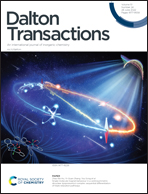Cyclam with a phosphinate-bis(phosphonate) pendant arm is a bone-targeting carrier of copper radionuclides†
Abstract
Ligands combining a bis(phosphonate) group with a macrocycle function as metal isotope carriers for radionuclide-based imaging and for treating bone metastases associated with several cancers. However, bis(phosphonate) pendant arms often slow down complex formation and decrease radiochemical yields. Nevertheless, their negative effect on complexation rates may be mitigated by using a suitable spacer between bis(phosphonate) and the macrocycle. To demonstrate the potential of bis(phosphonate) bearing macrocyclic ligands as a copper radioisotope carrier, we report the synthesis of a new cyclam derivative bearing a phosphinate-bis(phosphonate) pendant (H5te1PBP). The ligand showed a high selectivity to CuII over ZnII and NiII ions, and the bis(phosphonate) group was not coordinated in the CuII complex, strongly interacting with other metal ions in solution. The CuII complex formed quickly, in 1 s, at pH 5 and at a millimolar scale. The complexation rates significantly differed under a ligand or metal ion excess due to the formation of reaction intermediates differing in their metal-to-ligand ratio and protonation state, respectively. The CuII-te1PBP complex also showed a high resistance to acid-assisted hydrolysis (t1/2 2.7 h; 1 M HClO4, 25 °C) and was effectively adsorbed on the hydroxyapatite surface. H5te1PBP radiolabeling with [64Cu]CuCl2 was fast and efficient, with specific activities of approximately 30 GBq 64Cu per 1 μmol of ligand (pH 5.5, room temperature, 30 min). In a pilot experiment, we further demonstrated the excellent suitability of [64Cu]CuII-te1PBP for imaging active bone compartments by dedicated small animal PET/CT in healthy mice and subsequently in a rat femoral defect model, in direct comparison with [18F]fluoride. Moreover, [64Cu]CuII-te1PBP showed a higher uptake in critical bone defect regions. Therefore, our study highlights the potential of [64Cu]CuII-te1PBP as a PET radiotracer for evaluating bone healing in preclinical and clinical settings with a diagnostic value similar to that of [18F]fluoride, albeit with a longer half-life (12.7 h) than 18F (1.8 h), thereby enabling extended observation times.



 Please wait while we load your content...
Please wait while we load your content...